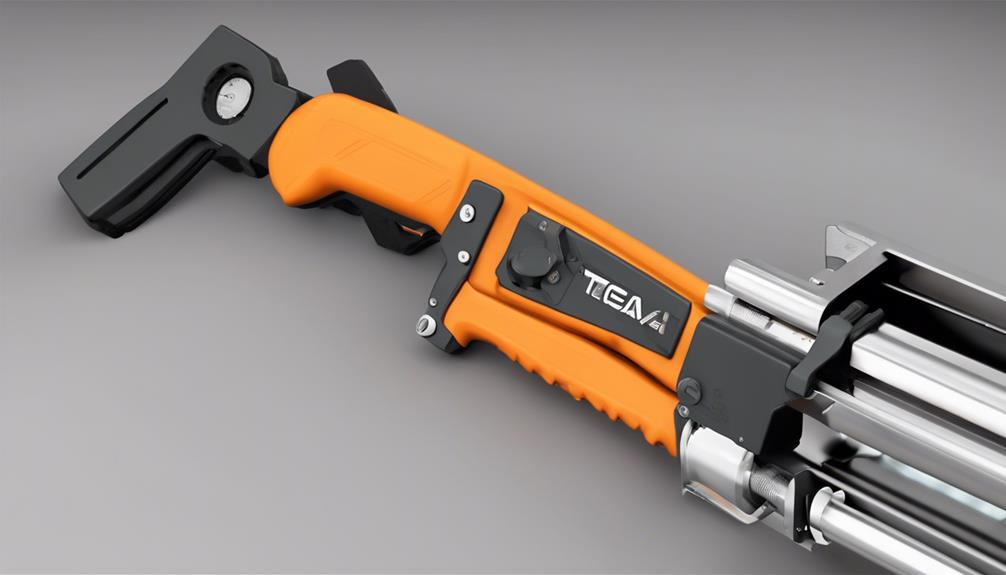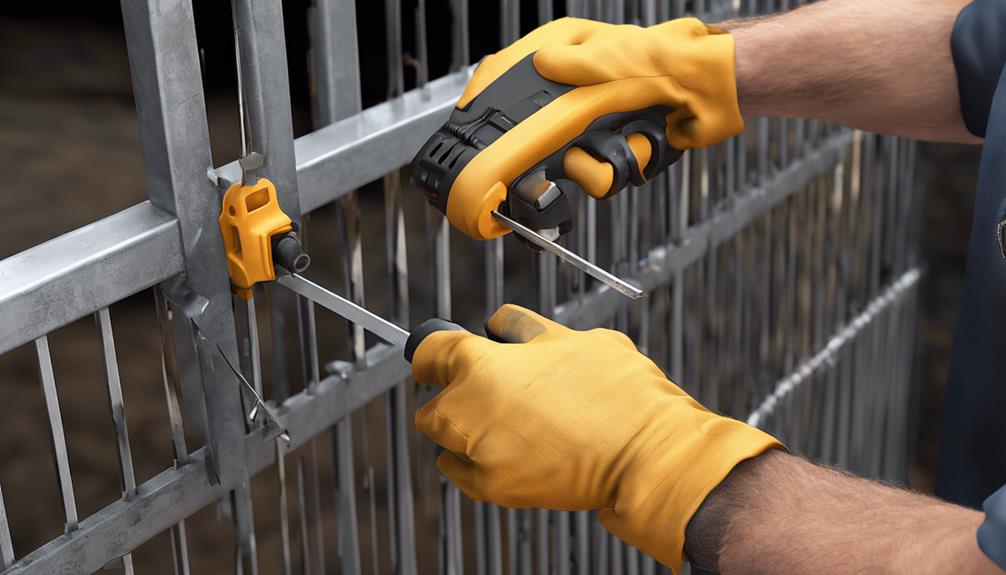If you want a tool that offers precise wire tensioning along with a manual cut-off tie feature and a comfortable grip, a tensioning tool with these capabilities is what you're searching for. Its durable steel construction and ergonomic handle design guarantee efficient performance. The dual functionality allows for quick tying and cutting, enhancing your workflow. By following usage instructions and maintenance tips, you can maximize its benefits. This tool finds its use in fencing, DIY projects, home improvements, crafting, and outdoor renovations.
Key Takeaways
- Durable steel construction ensures longevity and reliability.
- Ergonomic handle design for comfortable and efficient use.
- Precise tension adjustment capabilities for optimal results.
- Dual functionality for tying and cutting operations in one tool.
- Remarkable cutting efficiency for streamlined workflow.
Key Features

Key features of the tensioning tool with manual cut-off tie tool include a durable steel construction, ergonomic handle design for comfortable use, and precise tension adjustment capabilities.
The dual functionality advantages of this tool stem from its ability to not only tighten ties efficiently but also cut them swiftly when needed. The ergonomic design ensures that prolonged use doesn't lead to discomfort or strain on the user's hands, making it suitable for extended tasks.
The tool's durability is a significant advantage, as it's constructed from robust steel that can withstand the rigors of regular use without succumbing to wear and tear easily. This durability ensures that the tool remains reliable over an extended period, decreasing the need for frequent replacements or repairs.
Additionally, the cutting efficiency of this tool is remarkable, as it allows for quick and precise cutting of ties without requiring a separate tool.
Moreover, the precise tension adjustment capabilities of the tool enable users to achieve the desired level of tightness when securing ties, ensuring that items are held securely in place. This feature adds a layer of versatility to the tool, making it suitable for a wide range of applications where different levels of tension may be required.
Benefits of Dual Functionality
The dual functionality of the tensioning tool with manual cut-off tie tool enhances efficiency in tying and cutting operations. This integration combines the actions of tensioning and cutting into a single tool, streamlining the process and eliminating the need to switch between different tools. The convenience of having both functions in one tool saves time and effort, making it a versatile solution for various applications.
By incorporating both tensioning and cutting capabilities into a single tool, users benefit from increased efficiency. The smooth shift between tensioning and cutting tasks reduces the time required to complete each step, resulting in faster overall operation. This efficiency is particularly advantageous in situations where time is of the essence, such as in high-demand settings or time-sensitive projects.
The dual functionality of the tensioning tool with manual cut-off tie tool also enhances convenience. Users no longer need to carry multiple tools or switch between different equipment to perform tying and cutting tasks. This consolidation simplifies the workflow, ensuring a more straightforward and user-friendly experience.
Additionally, the ergonomic design of the tool with a comfortable grip further enhances usability, making it a practical choice for various users across different skill levels.
How to Use the Tool

To properly utilize the tensioning tool with manual cut-off tie tool, follow these step-by-step instructions for efficient operation:
Usage Instructions
- Step 1: Secure the Tool
- Position the tie tool around the material to be fastened.
- Confirm the grip is firm and secure before proceeding.
- Step 2: Apply Tension
- Begin tensioning by rotating the handle clockwise.
- Continue until the desired tension is achieved.
- Step 3: Cut Off Excess
- Use the manual cut-off tie tool to snip the excess tie.
- Ensure a clean cut for a secure fastening.
Troubleshooting Tips
- Issue: Excessive slack in the tie.
- Solution: Retension the tie by repeating step 2.
- Issue: Difficulty in cutting the tie.
- Solution: Check the blade sharpness and confirm proper alignment before cutting.
- Issue: Tool slipping during tensioning.
- Solution: Adjust the grip and confirm a secure hold before tensioning.
| Step | Instructions |
|---|---|
| 1. Secure the Tool | Position the tie tool and confirm a firm grip. |
| 2. Apply Tension | Rotate handle clockwise until desired tension is reached. |
| 3. Cut Off Excess | Snip excess tie using the manual cut-off tie tool. |
Maintenance and Care Tips
For optimal performance and longevity, regularly inspect and clean the tensioning tool with manual cut-off tie tool. Proper maintenance guarantees that the tool functions effectively and lasts longer.
Begin by wiping down the tool after each use to remove any dirt, debris, or residue. Use a clean cloth dampened with a mild detergent solution to clean the exterior surfaces. Avoid using harsh chemicals that could damage the tool.
Periodically check the tool for any signs of wear or damage. Inspect the blades of the cut-off tie tool for sharpness and any nicks that may affect cutting performance. If needed, sharpen the blades or replace them according to the manufacturer's guidelines. Lubricate any moving parts with a light machine oil to keep the tool operating smoothly.
When not in use, store the tensioning tool in a dry and secure place. Avoid exposing it to extreme temperatures or humidity, as this can cause damage to the tool over time. Store the tool in its original case or a designated toolbox to protect it from dust and potential impacts.
Applications and Projects

Explore the tensioning tool with manual cut-off tie tool to determine its suitability for various applications and projects. This versatile tool can be utilized in a multitude of practical applications and project ideas. For instance, in fencing projects, the tensioning tool can be used to tighten wires efficiently, ensuring a secure and durable fence structure. Its manual cut-off tie tool feature comes in handy for trimming excess wire, providing a clean and professional finish.
When it comes to creative uses, consider incorporating the tensioning tool in DIY projects such as creating trellises for climbing plants in your garden. The tool's ability to tension wires with precision can help establish sturdy supports for plants to grow vertically, optimizing space and adding a decorative element to your outdoor space. Additionally, the manual cut-off tie tool can assist in securing the wires in place, ensuring the trellis remains stable over time.
Whether you're working on home improvement tasks, crafting projects, or outdoor renovations, the tensioning tool with manual cut-off tie tool offers a range of possibilities. Its ease of use and practical functionalities make it a valuable addition to your toolkit, enabling you to tackle various projects with efficiency and precision. Experiment with different project ideas and creative uses to maximize the full potential of this versatile tool.
Conclusion
To sum up, the tensioning tool paired with a manual cut-off tie tool with grip provides a versatile solution for various applications and projects. Its dual functionality offers efficiency and convenience, making it a valuable tool for any job requiring tensioning and cutting of ties.
By following proper maintenance and care tips, users can guarantee the longevity and effectiveness of this tool in their work.
